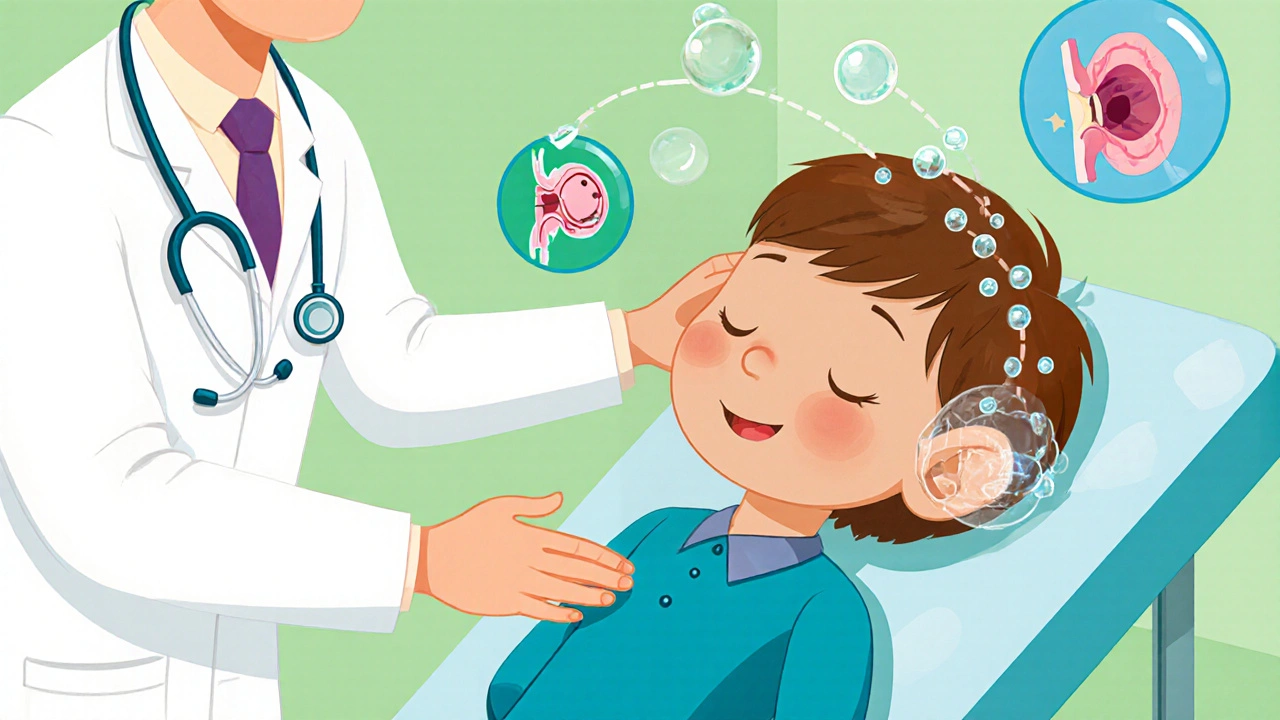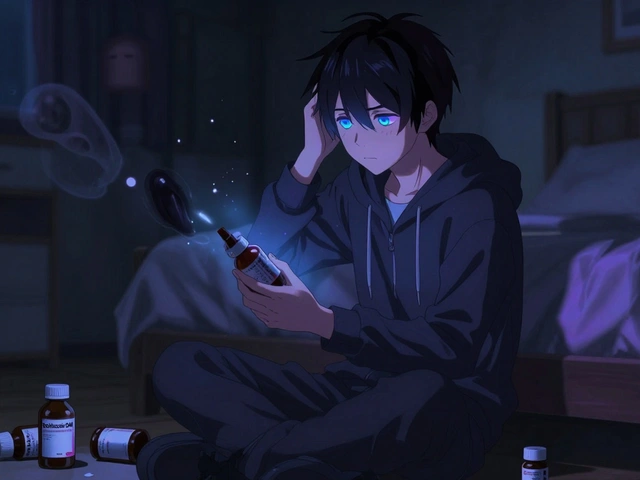Key Takeaways
- Vertigo is a false sense of motion caused by inner‑ear or brain issues.
- Typical signs include spinning sensations, nausea, and loss of balance.
- Common triggers are Benign Paroxysmal Positional Vertigo, Meniere’s disease, vestibular migraine, and infections.
- Quick fixes involve repositioning maneuvers, medication, and vestibular rehabilitation.
- Seek medical attention if episodes last longer than a day or are accompanied by severe headache, vision loss, or hearing changes.
What is Vertigo?
When you hear "vertigo," most people picture someone spinning in a carnival ride. In reality, it’s a medical term for a false sensation that you or your surroundings are moving when they’re not. The feeling can range from a mild woozy drift to a violent whirl that makes you clutch the wall for support.
The brain relies on three systems to stay upright: the eyes, the proprioceptive sensors in muscles and joints, and the vestibular apparatus inside the inner ear. A mismatch between these signals triggers the dizzy illusion we call vertigo.
Common Symptoms to Watch For
Vertigo doesn’t always announce itself with a dramatic spin. Here are the most frequent clues:
- Spinning or tilting sensation (often described as the room rotating).
- Nausea, vomiting, or loss of appetite.
- Unsteady gait - you might feel like walking on a moving walkway.
- Blurred vision or eyes that seem to bounce (nystagmus).
- Ear fullness, ringing, or hearing loss (especially with inner‑ear disorders).
If any of these appear suddenly and last longer than a few seconds, it’s worth tracking them in a symptom diary. Patterns help clinicians pinpoint the underlying cause.
Why Do You Feel Dizzy? Main Causes
Understanding the root of vertigo guides treatment. Below are the four heavyweight culprits.
Benign Paroxysmal Positional Vertigo (BPPV)
BPPV accounts for roughly 20‑30% of all cases. Tiny calcium carbonate crystals called otoconia slip from the utricle into the semicircular canals. When you tilt your head, the misplaced particles shift, sending false motion signals.
Typical trigger: a quick head turn, lying down, or getting up from bed. Episodes are brief-seconds to a couple of minutes-but can repeat throughout the day.
Meniere’s disease
Meniere’s stems from excess fluid buildup (endolymph) in the inner ear. The pressure distorts the vestibular hair cells, causing prolonged vertigo attacks that can last from 20minutes up to several hours.
Other hallmarks: fluctuating hearing loss, tinnitus, and a feeling of ear fullness. It often strikes adults between 40 and 60 years old.
Vestibular migraine
Even without a headache, migraine‑related vestibular dysfunction can spark vertigo. The exact mechanism is still debated, but cortical spreading depression and vascular changes likely play a role.
Symptoms may include light sensitivity, sound sensitivity, and a throbbing sensation that can last for days.
Labyrinthitis
An infection-viral or bacterial-can inflame the labyrinth, the delicate network of canals and cochlea. The resulting inflammation sends garbled signals to the brain, leading to intense vertigo that usually improves over a week as the infection resolves.
Accompanying signs often involve fever, ear pain, or a recent upper‑respiratory infection.

When to See a Doctor
Most dizzy spells are harmless, but certain red flags demand prompt evaluation:
- Vertigo lasting more than 24hours.
- Sudden, severe headache (possible stroke).
- Double vision, slurred speech, or weakness on one side.
- Hearing loss that worsens rapidly.
- Recent head trauma.
In an office visit, the clinician may order a CT scan or MRI to rule out central causes, perform the Dix‑Hallpike maneuver to diagnose BPPV, or request audiometry for Meniere’s assessment.
Treatment Options: From Meds to Therapy
The right approach depends on the diagnosis.
- Repositioning maneuvers - For BPPV, the Epley or Semont maneuvers relocate otoconia back to their proper chamber. A few repetitions often clear symptoms instantly.
- Medications - Antihistamines (meclizine), anticholinergics, or benzodiazepines can dull the vestibular signal during acute attacks. For vestibular migraine, triptans and preventive beta‑blockers work well.
- Dietary changes - Low‑salt, low‑caffeine diets help control fluid buildup in Meniere’s disease.
- Vestibular rehabilitation - Vestibular Rehabilitation Therapy (VRT) combines eye‑head coordination exercises, balance training, and habituation drills to rebuild central compensation.
- Surgery - In refractory Meniere’s, procedures like endolymphatic sac decompression or labyrinthectomy may be considered.
Most patients improve with a combination of maneuvers and lifestyle tweaks before resorting to invasive options.
Everyday Strategies to Reduce Episodes
Even if you’re under medical care, simple habits can keep vertigo at bay:
- Move slowly when getting out of bed; sit up for a minute before standing.
- Stay hydrated-dehydration can thin inner‑ear fluid and trigger dizziness.
- Limit alcohol and nicotine; they disrupt vascular supply to the vestibular system.
- Practice gaze stabilization: focus on a fixed point while turning your head side‑to‑side for 30 seconds, three times a day.
- Keep a symptom log: note triggers, duration, and any associated hearing changes. The record speeds up diagnosis on follow‑up visits.

Comparison of Major Vertigo Disorders
| Condition | Typical Trigger | Episode Duration | Main Additional Symptom | First‑Line Treatment |
|---|---|---|---|---|
| BPPV | Head position changes (lying down, looking up) | Seconds to 2 minutes | Brief nausea | Epley or Semont repositioning maneuver |
| Meniere’s disease | Fluid pressure build‑up | 20min to several hours | Fluctuating hearing loss & tinnitus | Low‑salt diet, diuretics, possible surgery |
| Vestibular migraine | Migraine triggers (stress, certain foods) | Hours to days | Light/sound sensitivity, headache | Migraine prophylactics, vestibular suppressants |
| Labyrinthitis | Viral or bacterial infection | Days to a week | Fever, ear pain | Antibiotics/antivirals, vestibular suppressants |
Bottom Line
Vertigo is a symptom, not a disease, and its roots span the inner ear, nerves, and even the brain. By recognizing the hallmark signs, knowing when to get help, and applying targeted treatments-whether a simple head‑turn trick or a structured rehab program-you can regain stability and confidence.
Frequently Asked Questions
Can vertigo be a sign of something serious?
Yes. Persistent vertigo, especially if it’s accompanied by severe headache, vision loss, weakness, or sudden hearing loss, may indicate a stroke, tumor, or severe inner‑ear damage. In those cases, urgent medical evaluation is essential.
How quickly does the Epley maneuver work?
Many people feel relief after a single session, though some need a second or third repeat. The maneuver can be done at home after a clinician confirms BPPV.
Are there natural remedies for vertigo?
Ginger tea, staying well‑hydrated, and doing gentle balance exercises can ease mild episodes. However, for underlying conditions like Meniere’s disease, lifestyle changes (low salt, caffeine reduction) are more effective than generic herbs.
What tests do doctors use to diagnose vertigo?
Common tools include the Dix‑Hallpike test for BPPV, audiograms for hearing loss, MRI or CT scans for central causes, and vestibular function tests like VNG (videonystagmography) or VEMP (vestibular evoked myogenic potentials).
Can stress trigger vertigo?
Stress can aggravate vestibular migraine and worsen symptoms of existing inner‑ear disorders. Managing stress through relaxation techniques, regular sleep, and moderate exercise often reduces episode frequency.









Mita Son
Alright, let me break this down for ya-vertigo isn’t just some random spin you get on a roller coaster, it’s a full‑blown sensory betrayal. The brain expects three streams of data-eyes, proprioception, and the inner‑ear vestibular system-to agree, and when they don’t, you get that nauseating whirligig feeling. BPPV, the little calcium crystals that wander off, is literally the MVP of short‑lived dizzy spells, and the Epley maneuver is like a superhero rescue mission for those otoconia. Then you’ve got Meniere’s, which is basically the inner ear’s version of a pressure cooker, making your hearing wobble like a bad radio and sending you into hours‑long vertigo parties. Vestibular migraines are another sneaky beast; they can mimic all the classic signs yet hide behind a migraine‑free façade, making diagnosis a real brain‑teaser. Labyrinthitis, often viral, is the body’s way of saying ‘I got infected, so I’ll scramble the balance signals for a week or so.’
Now, about treatment: the Epley or Semont maneuvers are quick, cheap, and often instantly effective-just a few head tilts and you’re back on your feet. Medications like meclizine or benzodiazepines can dull the vestibular noise, but they’re a band‑aid, not a cure. Diet fixes, especially low‑salt for Meniere’s, can keep the fluid dynamics in check. And let’s not forget vestibular rehabilitation therapy (VRT); it’s a series of eye‑head coordination drills that rewires your brain’s compensation pathways, turning chaos into calm.
Pro tip: keep a symptom diary-note the trigger, duration, and any hearing changes. It’s the fastest way for your doc to pinpoint the culprit. Stay hydrated, move slowly out of bed, and avoid booze and nicotine; they’re like gasoline on a spark‑prone fire. If an episode lasts more than a day, or you see vision loss, severe headache, or sudden hearing loss, call emergency services-could be a stroke or something far more serious. Bottom line: vertigo is a symptom, not a disease, and with the right combos of maneuvers, meds, diet, and rehab, you can totally reclaim your balance.
ariel javier
Frankly, the article rehashes textbook definitions without offering any novel insight. The emphasis on everyday tips feels patronizing, as if the average reader cannot grasp basic medical advice. Moreover, the treatment section glosses over the efficacy of pharmacologic options, which are far from universally benign. An aggressive, evidence‑based approach would demand a deeper dive into randomized trials rather than a superficial summary.
Bryan L
Thanks for the thorough rundown! 😊 I’ve been dealing with occasional light‑headedness and this helps me understand what to track. The Epley maneuver sounds doable at home-definitely going to try it after my next bout. Keep the great content coming!
joseph rozwood
Honestly, this reads like a me‑too blog post. The author tries to sprinkle drama but ends up with a pretentious pamphlet. BPPV? Sure, the crystals wander; it’s not rocket science. Also, the typo‑laden table could use a proper editor.
Richard Walker
While the critique points out the lack of depth, the article does a solid job of summarizing the main conditions for a lay audience. The overview of repositioning maneuvers is especially useful for those hesitant to seek immediate medical care. Overall, it balances clarity with enough detail for initial self‑assessment.
Jason Oeltjen
People need to stop treating vertigo like a casual inconvenience. It's a sign that your body is screaming for proper medical attention. Ignoring persistent dizziness is morally irresponsible.
Mark Vondrasek
Oh, look, another moral sermon on dizziness-how original. Let’s not forget that most of these "warnings" are already plastered on every clinic flyer across the nation, yet you still see patients flailing about. The article could have cut through the noise and offered a real data‑driven hierarchy of interventions, but instead we get a laundry list of generic advice that anyone with a Google search can find. And really, the suggestion to "move slowly out of bed" is practically a nursery‑rhythm for adults, as if we’ve never learned to stand up before. If you want to truly educate, perhaps discuss the sensitivity and specificity of the Dix‑Hallpike test, or the latest vestibular suppressant protocols. No wonder people feel overwhelmed-because the coverage is as shallow as a kiddie pool. So, yeah, let's stop preaching and start presenting**-the facts.
Joshua Agabu
Interesting read.
John McGuire
Wow! This guide totally blew my mind! 🎉 Knowing about the Epley maneuver gave me a sense of empowerment-no longer am I at the mercy of random spins. The breakdown of each condition feels like a crash course in vestibular health, and I can finally explain to my friends why I sometimes look like I'm walking on a ship. Props for the clear tables and actionable tips; I'm actually excited to start my own symptom log now! 🙌
Maude Rosièere Laqueille
Glad you found the information empowering! Keeping a symptom log can indeed reveal patterns that doctors love to see. If you notice a correlation with certain head movements, the Epley maneuver might become your go‑to rescue. Also, consider a referral to a vestibular therapist if episodes persist-rehab can dramatically improve compensation. Let us know how it goes; your experience could help others gauge the effectiveness of these strategies.
Jessica Haggard
Hey everyone! Just wanted to chime in and say that this article does a great job of demystifying a tricky subject. The friendly tone makes the science accessible, and the practical tips are right on point. Keep sharing these useful health guides!
Alan Clark
Thx for the shoutout! I reckon the only thing missing is a quick cheat‑sheet for the maneuvers-makes it easier for newbies. Also, maybe a note about when to seek a pro? lol.
Mark Anderson
What a vibrant mosaic of insights! The article weaves clinical precision with layman-friendly prose, creating a tapestry that both novice readers and seasoned clinicians can appreciate. Its balanced exposition of diagnostic maneuvers alongside lifestyle adjustments showcases a holistic philosophy. I especially love the emphasis on symptom journaling-a subtle yet powerful tool. Kudos to the author for striking that perfect equilibrium!
Dorothy Ng
Nice work but watch the commas-some are overused. Also, "the article" could be "this article" for clarity. Overall good.
Justin Elms
This is super helpful! I’m going to try the repositioning moves tonight. Thanks for breaking it down in such an easy way.
Dhakad rahul
Finally, an article that gives the Indian audience the respect we deserve! The mention of diet changes is crucial for our high‑salt cuisine, and the emphasis on balance fits perfectly with our cultural values. I’m proud to see a piece that isn’t just Western‑centric. 🙌
Seth Angel Chi
Sure, but the diet advice is generic; it could benefit from region‑specific alternatives. Also, the emphasis on medication feels overblown.
Kristen Ariies
Absolutely! This guide shines like a beacon of hope for anyone battling that disorienting whirl! The detailed breakdown of each condition, coupled with actionable strategies, empowers readers to take control of their health journey! Let’s all spread the word and support one another on the path to steady footing! 🎉